
| Stage 2 - Fraser Island Great Walk |
|
|
|
|||
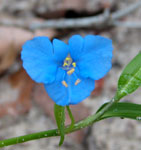 |
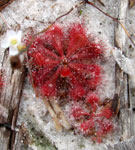 |
 |
 |
|
|
|
|
|
 Flower-spikes of tussock grass |
 On the shores of Lake Garawongera |
|
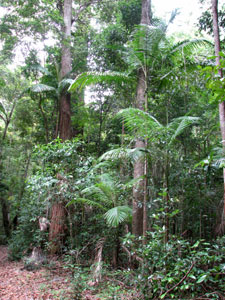 Piccabeen palms in the rainforest |
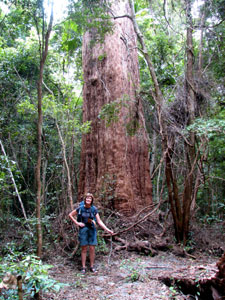 First of the big trees |
Leaving the lake we descended through woodland before a long zig-zag took us past a small swamp and into an area of ferny understorey with scattered cycads - the trees were starting to become noticeably taller. Straightening up again, we headed east, picking up an old forestry track that descended into an increasingly lush and tall area of rainforest. The path became a carpet of leaves that crunched beneath our feet as we passed some of the first forest giants, over 8m in diameter with their crowns reaching 40-50m into the sky, making a curious contrast to the thin and delicate trunks of the understorey of piccabeen palms. |
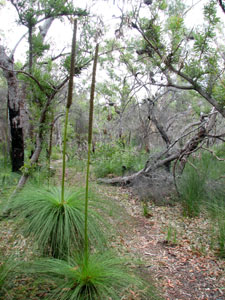 Grass trees in the Wallum heathland |
|
|||
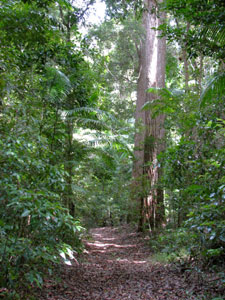 Deep in the rain forest
 Bush rat behaving badly |
The vegetation became rapidly drier and sparser as we climbed higher and soon we found ourselves walking through a dry heathland of banksia, tea-trees and grass trees that had not long been burnt in a fire. The sun, which had by now broken through the cloud cover glared at us from the white sand of the track and sparse overstorey. However, within a kilometre of crossing the top of the dune and commencing a long slow descent, the vegetion rapidly changed as heath turned into woodland and woodland into rainforest - once again we were walking on a leafy carpet beneath the giant brushbox and satinays. Welcome to the Valley of the Giants!
A few kilometres into the forest we reached our campsite - with its welcome water tap, well-set out tent sites, platforms for sitting on and dingo-proof steel food boxes. The planners have done a good job with these campsites and its setting in the midst of the giant rainforest trees was an extremely peaceful one, with small yellow robins hopping about our campsite, the signature bush call of the whipbird overhead and the nocturnal scurryings of the bush rats for company. There was but one problem here (and it may well be seasonal) - between us the Fair Nello and I killed over 200 March flies undertaking suicide missions in search of blood! |
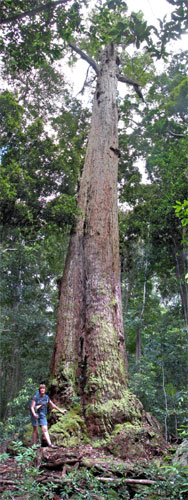 Now here the trees are really big! Giant tallowwood in the Valley of the Giants |
|
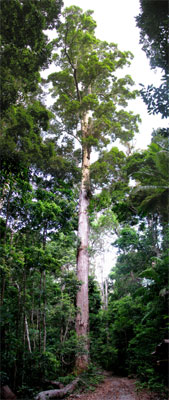 Giant Satinay |
 Leaf-covered rainforest track |
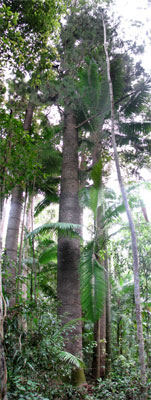 Giant kauri |
Later that afternoon, we wandered quietly under the canopy of the forest giants, tallow wood, satinay, kauri pine, brush box, some up to 1000 years old and towering up to 70m above our heads - this is a great place to come and reflect on the significance of our own existence. It was comforting to know that, since Fraser Island was declared a world heritage area, they may well be there in another 1000 years! |
|
||
|
||
- 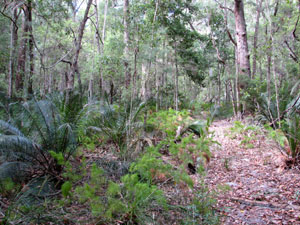 - -Cycads and asparagus-ferns carpeting the dry sclerophyll forest |
Eventually we climbed up and out of the depression; the landscape changed rapidly from rainforest to much drier woodland, carpeted with asparagus ferns and cycads. At the top of the long ridge, a sign pointed to the lookout over the Badjala Sandblow. We left our packs at the sign and wandered out, climbing the steep face of the dune, where vegetation and sand fought for dominance, to emerge at the head of a massive sheet of sand stretching out above the forest towards the blue waters of the Pacific beyond. Here the cool wind blew unimpeded and we relaxed in the shade of a small lone tree on the dune, taking in the view and the letting the wind blow away the stickiness of the last few kilometres. |
-  - -View across the Badjala Sandblow |
|
 Sandy 4WD track in wet sclerophyll forest |
Tent set up, we had a quick lunch and headed off for the 3km sidetrip to Lake Wabby. The setting of this lake is spectular, with the golden sands of the Hammerstone Sandblow descending steeply down to plunge into its warm dark waters, facing a backdrop of thick green forest at its far side. Visit it soon if you want to see it - each year the sandblow consumes a little more the lake as it spreads inland! |
 Cool at last! |
|
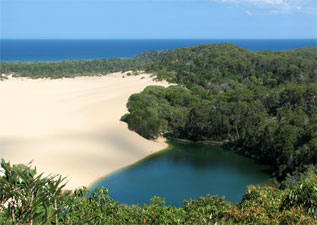 The beautiful setting of Lake Wabby |
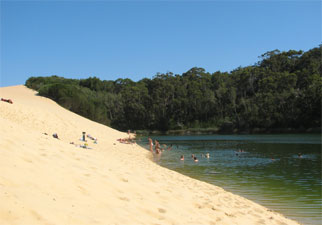 The Hammerstone Sandblow is slowly swallowing the lake |
|
|
|
          |
|
It was another warm sunny morning as we left the "Not Lake Wabby" campsite and followed a long ridge under open woodland. The sandy path, as along most of the tracks on the island, was covered with the entrances and mounds of the huge ant population that calls this sandmass home. They have a sizeable part of the recycling contract on the island and carry out their task with gusto. I noted that a swatted March fly never lasted more than a minute before being discovered and carried off by the ants into their nests - it felt good to be contributing to this recycling process!
|
|
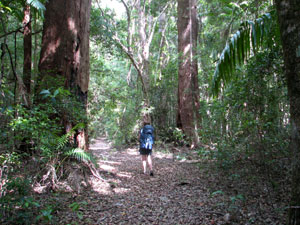 Leafy track beneath the big trees |
Eventually the track descended slowly into a damper valley; trees became taller, shade deeper, and the first piccabeen palms announced our arrival in another section of rainforest. We were treated to a close-up encounter with a 3m long carpet python; its beautifully patterned body draped over a fallen log on the side of a path. After looping around through the rainforest, the track climbed up and followed the contour of the ridge - below us the sharp ecotone between wetter and drier forest was clearly visible. |
 -- -- 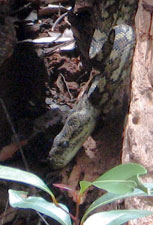 2m carpet python beside the track (only a tiddler!) |
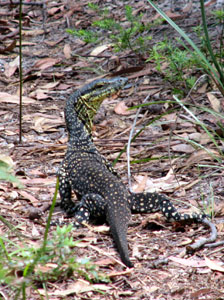 Another big goanna |
A few goannas and large skinks wandered across the path ahead of us on this day of reptilian encounters, as we trudged across the crackling sticks and eucalypt twigs that were strewn over the track. To our left, the first glimpses of Lake Mackenzie (or Boorangoora, as the indigenous Butchulla people call it) appeared through the trees and soon we found ourselves descending a white sandy 4WD track toward the lake. Below, the brilliant white sandy beach and blue waters urged us on. Another half kilometre and we arrived at the walker's camp in its dingo-proof fence adjacent to the day-trippers car park. Another disappointing lake arrival - it was very easy to wonder why we had put in the hard effort of walking in to this beautiful site when everyone else just drove there. I feel that walker's camps should be well away from the car visitors to preserve the sense of isolation that the walker seeks.
|
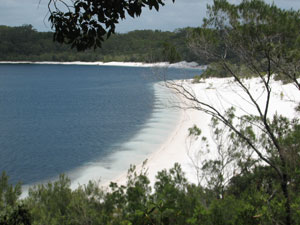 The brilliant white shoreline of Lake McKenzie |
|
|
|
|
 |
|
|
||
For the first night we were alone at the campground and, after dinner, we took a stroll down to the beach once more. A gentle cool breeze wafted across the lake, which was silent apart from the soft lapping of wind ripples on the shore and the soothing chorus of frogs drifting across from the reed beds. Venus was shining brightly in the west and Mars in the east, and the clouds drifted slowly across the face of an almost full moon. The brilliant white sands gleamed in the moonlight and the distant beaches showed up like a string of pearls around the dark lake waters. This was certainly one of those moments; strolling hand-in-hand with the fair Nello on a moonlit beach of a beautiful lake, the only two people far from civilisation. This is what it is all about - this is why we are happy to walk 75 km with heavy packs on our backs. Aah, it becomes clear, Boorangoora, we were wrong to judge you by daylight, you save your magic for the night; free from the madding crowds. |
 Magic moonlit moments |
     |
|
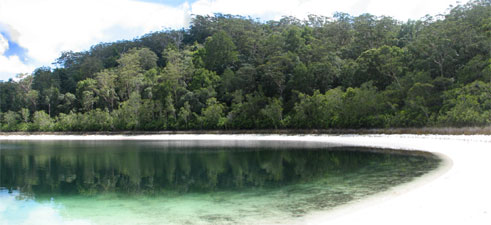 Emerald water +white sand = Basin Lake |
A short climb out of the lake depression saw us descend slowly into the next hollow, which held a small swamp, before climbing steeply through woodland to reach Basin Lake. This small lake has to be one of the most beautiful perched lakes, with its limpid waters surrounded by a circle of white sand beach, set deep in a hollow of dense eucalypt forest. A quick dip soothed our bodies, which felt like we had gone through an involuntary acupuncture session after the attack of the March flies.
|
From Basin Lake the track angled down a steep dune ridge; trees gradually became taller and vegetation denser and soon we found ourselves once again in the lush rainforest of a water-rich dune valley. A few hundred metres further on and we were walking along the meandering boardwalk beside the crystal clear waters and sandy bed of palm-lined Wanggoolba Creek. On the south side of the creek lay Central Station, with its historic buildings and tree plantings from a 1920s forestry venture.
By now, we were beginning to anticipate the pattern of the walk and knew that the previous steep descent meant an equally steep climb up out of the valley on to the central high dunes, covered with a tall eucalypt forest containing massive blackbutt, brush box and satinay trees. |
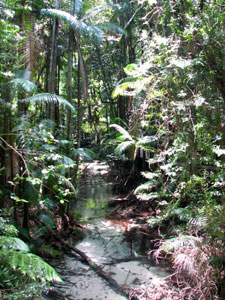 Palm-lined Wanggoolba Creek |
 Strangler fig enveloping the trunk of its host |
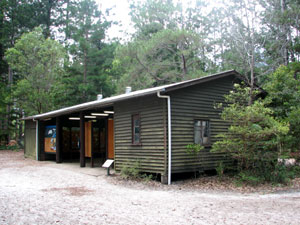 1920s seed-drying hut at Central Station |
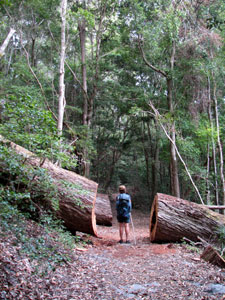 Path through a fallen forest giant |
|
|
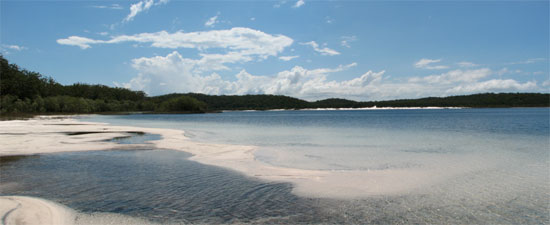 The sun returns to Lake Birrabeen |
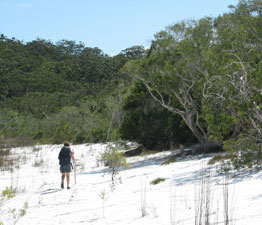 Heading to Benaroon |
 Old man paperbark |
|
||
|
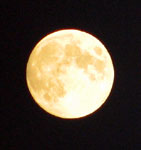             |
|
|
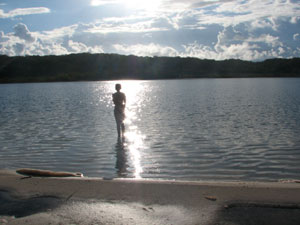 Early morning by the lake |
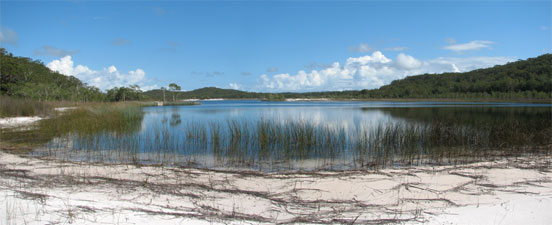 Farewell Lake Benaroon |
 Tea-tree silhouettes |
Rainbow bee-eater feeding on a dragonfly
After a brief break, we crossed over its northern edge; a broad stretch of sand and reeds, across which meandered the shallow tannin-stained waters of small streamlets flowing into the lake. The contrast of brilliant white sand and honey-coloured watercourse was striking.
|
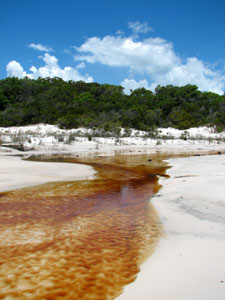 Inflow into Lake Boomanjin |
|
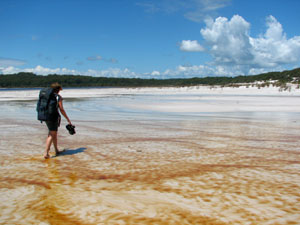 Crossing the northern basin of Lake Boomanjin |
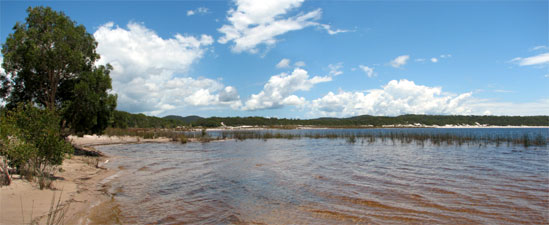 Tannin-stained waters of Lake Boomanjin, the largest perched lake in the world |
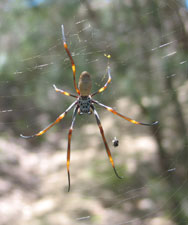 Golden orb spider waiting for unwary insects and bushwalkers |
We climbed up to see the wind-sculpted pale golden sands of the sandblow slowly creeping forward into the forest, with the deep blue of the Pacific visible in the distance.
|
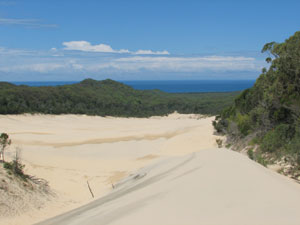 Looking down the Wongi Sandblow toward the Pacific |
|
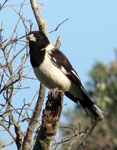 Pied butcherbird - bush songster |
||
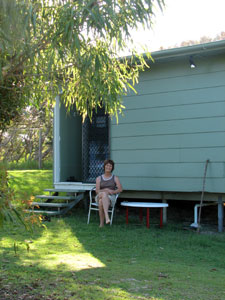 Relaxing in front of the cabin at Dilli with its .... |
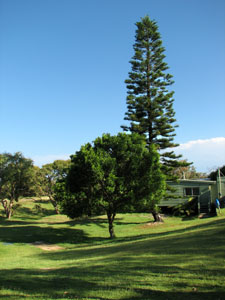 .... green oasis and ..... |
 .... cool dark waterhole |
On whinging about biting flies
|
|
     |